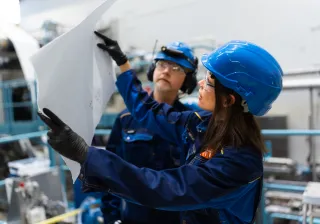The City of Tampere aimed to improve its ability to anticipate future developments. VTT’s foresight training is now helping the city identify future opportunities, prepare for uncertainties in its operating environment and make more sustainable, inclusive and impactful decisions over the long term.
Key facts
Tampere sought to strengthen and expand its foresight capabilities.
Five in-person training days and targeted small-group remote coaching for 21 city experts.
Measurably improved and more systematic foresight capabilities.
Why is foresight important for cities?
In today’s volatile and fast-changing world, cities need more systematic and diverse foresight operations to support long-term strategic planning. Foresight plays a central role in Tampere’s current strategy, which is based on drivers of change and guides the city’s development through to 2030. The strategy has been shaped with broad stakeholder engagement for a shared vision for the future. It is vital that city employees across all levels can actively participate in foresight efforts.
To support this goal, Tampere partnered with VTT to deliver a foresight training programme for 21 city experts. The training covered themes such as foresight as an organisational capability, key foresight methods, strategic foresight and cities as users of foresight. The aim was to build future preparedness through familiarisation with key methods and support the creation of Tampere’s foresight operating model.

Participants gained hands-on foresight skills
Tampere’s experts received practical tools and methods to apply foresight in their daily work. Participants completed a self-assessment survey on their foresight capabilities before and after the training. The results showed a significant improvement, especially in methodological understanding and the ability to apply foresight in their roles. All indicators showed positive change.
In group work and practical exercises, the newly learned methods were applied to real-world challenges. The topics included:
Emission scenarios for urban mobility
Impact of the rising immigrant population
Dimensions of the city’s operating environment
Foresight operating model for a city organisation.
“Practical foresight exercises were a central part of the training. Participants applied their learning directly to ongoing projects. This required effort and time, but proved rewarding as theory turned into practice,” says Pauli Komonen, Senior Scientist at VTT and Project Manager of the training.
“The participants were impressively active. They asked insightful questions, supported one another in the practical exercises and brought new perspectives to the table. Their contributions enriched the discussions and supported collective learning,” says Minna Halonen, Research Scientist at VTT.
Foresight is now recognised as a strategic competence area, and we’re preparing a model to embed it into the city’s competence and learning management practices.

Embedding foresight into the organisational culture
Foresight is not just the task of top management – it should be part of the organisation’s culture and daily operations. By involving a wide range of experts, the training helped spread foresight competence throughout the city organisation.
“One of the key benefits was the chance for city experts who think about Tampere’s future in their work to come together. Even though their roles varied, the training fostered rich dialogue around the value of futures thinking and led to practical foresight experiments,” says Johanna Ahlgrén-Holappa, Head of Knowledge Management at the City of Tampere.
In Tampere, foresight is now closely linked to other functions, and its strategic value has been recognised.
“As a result, we’ve brought in additional experts from outside the training to develop city-level foresight activities. Foresight is now recognised as a strategic competence area, and we’re preparing a model to embed it into the city’s competence and learning management practices,” says Ahlgrén-Holappa.
Next steps include monitoring how foresight is used in practice and demonstrating its impact. For a fast-developing city like Tampere, futures literacy, the ability to explore alternative futures, and actively building desired futures are essential tools.
“We see growing signs, both in Finland and internationally, of the rising importance of foresight in cities. Foresight is becoming more systematic and networked, involving multiple stakeholders. Cities are powerful drivers of global change, and foresight is crucial to future-oriented decision-making,” VTT’s Pauli Komonen concludes.








